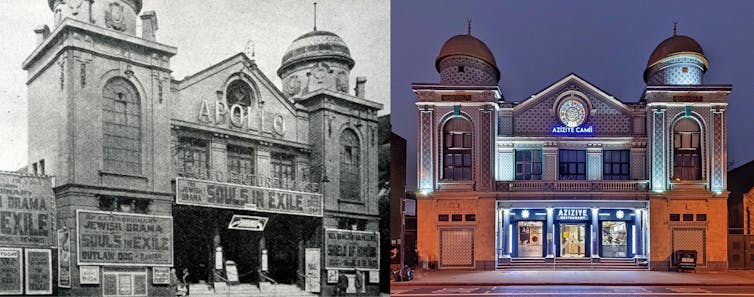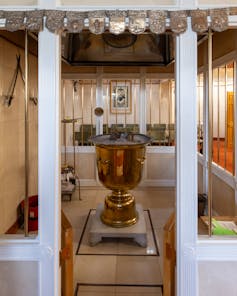On the corner of Powis Street and Woolwich High Street in south-east London stands a large brick building. Its curved exterior and wide canopy over the entrance immediately signals that it is a cinema.
Looking up, however, passers-by might be surprised to see that in large letters arranged on the building’s tower is the word “Cathedral”. A lower sign specifies it houses the Christ Faith Tabernacle, a Pentecostal church group founded in Nigeria.
Directly opposite is another former art deco cinema with “New Wine Church” emblazoned across the façade. This historic building now also houses a Nigerian Pentecostal megachurch.
Across England there are currently 99 cinemas that have similarly been reinvented. Some, like the Nanaksar Gurdwara Sikh temple in Coventry, have been places of worship for longer than they showcased films.
Since 2022, I have been researching these sites, talking to members of the congregations and their community leaders. The resulting database draws a fascinating snapshot of diasporic faith practices.
Adaptive reuse
The increasing number of empty churches across the country might suggest that faith is in decline. The 2021 UK census revealed that religious practice is, in fact, flourishing in many British cities. The numbers of Pentecostal Christians, Muslims, Hindus, Sikhs and Buddhists have all risen over the past decade.
These growing populations have not resulted, however, in commensurate numbers of purpose-built places of worship. Most minority communities have instead chosen to adapt secular buildings.
Repurposing existing buildings is common among migrant faith groups. The decline of movie-going from the early 1980s produced a ready supply of large buildings conveniently located in urban centres. These offered auditoriums for large congregations; spaces for community activities, soundproofing, parking and links to public transport.
Former cinemas were often cheap to buy and, until the late 1980s very few buildings were on the government’s statutory list, which provides legal protection from demolition and significant alteration. This meant that securing planning permission for change of use was generally straightforward.
The erstwhile Rex Cinema, on the corner of Chapel Street and Trinity Way in Salford, actually started out as a 19th Scottish Presbyterian Church before being converted into a cinema in the early 1900s. From 1967, it served as a bingo hall until the 1980s, when it was Grade-II listed and the New Harvest Christian Fellowship moved in.
Similarly, the 1910 King’s Theatre in Thanet, Kent, served as a theatre, a cinema and a church until 2017, when the Kent Tamil Association began converting it into a Hindu temple. The historic interior has been stripped out to open up the space.
The Sri Swarna Dhurgai Amman now features freestanding golden shrines, with roof lights, white walls and marble-effect floor tiles. The room feels light and bright.
Underfloor heating allows worshippers to attend in traditional dress and bare feet and the worship space is filled with the smell of incense and spices: the kitchen in one of the ancillary rooms providing food for all visitors.
Meanwhile, in Stoke Newington, north London, the Aziziye Mosque, which opened in 1983, occupies the 1913 Apollo Picture House. With funding from the UK Turkish Islamic Association, the space has been progressively gutted and the façade covered in an intricate mosaic.

North London’s Apollo Picture House (left) is now the Aziziye Mosque (right). Dominic Alves/flickr, CC BY-SA
New life for old buildings
A significant historic building being listed means that buying it and changing its use usually comes with regulatory challenges and costly refurbishments.
Despite this, many faith communities have chosen to remain in converted cinemas. Some organisations specifically seek old cinemas out for new locales.
The Brazilian Pentecostal church, the Universal Church of the Kingdom of God (UCKG), counts 14 branches in London. Three are housed in former cinemas, two of which are listed and have been restored to the highest conservation standards, at great cost. The group purchased a further cinema in London but failed to secure planning permission.
The Rayners Lane fire temple. The wub/Wikimedia, CC BY-SA
The listed former Ace Cinema on Rayners Lane in Harrow, north London, has been the Zoroastrian Centre since in 2000. The temple’s sacred fire is housed within what was the projection room.
Both the Freedom Centre International Church in Welling, Kent, and the Potters House Church in Leyton, east London, have spent considerable sums restoring the buildings in which they meet. These are not listed structures. As such, the occupants are under no legal obligations to protect the historical features.
By contrast, the Granada Theatre in Woolwich was grade-II listed when the Christ Faith Tabernacle community bought it in 2011 for £5 million. The building had been a bingo hall for decades and fallen into disrepair. The total amount the congregation has spent on the purchase and costly restorations (to, among other things, reinstate the cinema-style fixed seating and install a theatre organ) would certainly have paid for a purpose-built church building.
This suggests that cinema buildings provide exactly what many faith groups need. The Cathedral is perfectly suited to Pentecostal worship. The stage is used to deliver sermons and live music to worshippers numbering into the hundreds.
The advantages are more than simply practical, though. The manager tells me that, for the community, the gothic interior has a Christian flavour which provides the rationale for designating it as a cathedral.
This begs the question: why not repurpose one of the country’s increasing number of redundant churches instead of a cinema that looks like a church? One reason for this may be that former churches bring the weight of a religious tradition that newer denominations are deliberately moving away from.
Regulations that limit building reuse can deter faith communities from acquiring listed buildings. At the same time, it is vital that listing continues to identify, record and map significant buildings in inclusive ways.
The King’s Theatre in Thanet has certainly not been restored to its original Edwardian form. It would be hard to argue, though, that it hasn’t been enriched by its reuse as a temple.
Celebrating all layers of a building’s history is crucial. So too is ensuring that it fulfils the most basic requirement of all – that it be used.



 AI gives nonprogrammers a boost in writing computer code
AI gives nonprogrammers a boost in writing computer code  UBS "이 미국 도시, 부동산 거품 위험 가장 높아"
UBS "이 미국 도시, 부동산 거품 위험 가장 높아"  Bitcoin Boom: El Salvador Accumulates BTC While Traders Stay Cautious
Bitcoin Boom: El Salvador Accumulates BTC While Traders Stay Cautious  Gold Prices Soar to Record Highs Amid Central Bank Demand and Dollar Weakness
Gold Prices Soar to Record Highs Amid Central Bank Demand and Dollar Weakness  Monero’s Momentum: Privacy Coin on the Rise with Strong Market Prospects
Monero’s Momentum: Privacy Coin on the Rise with Strong Market Prospects  Stamp duty is holding us back from moving homes – we’ve worked out how much
Stamp duty is holding us back from moving homes – we’ve worked out how much  FxWirePro- Gold Trade Idea
FxWirePro- Gold Trade Idea  FxWirePro- Gold Trade Idea
FxWirePro- Gold Trade Idea  Hong Kong's Housing Market Slumps for Fifth Month: What’s Next?
Hong Kong's Housing Market Slumps for Fifth Month: What’s Next?  If you squat in a vacant property, does the law give you the house for free? Well, sort of
If you squat in a vacant property, does the law give you the house for free? Well, sort of 
































